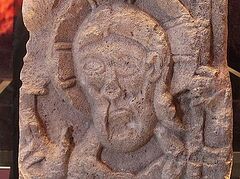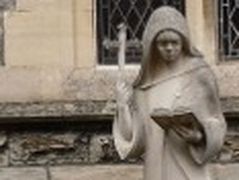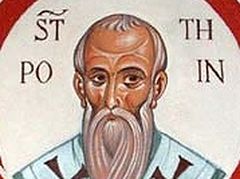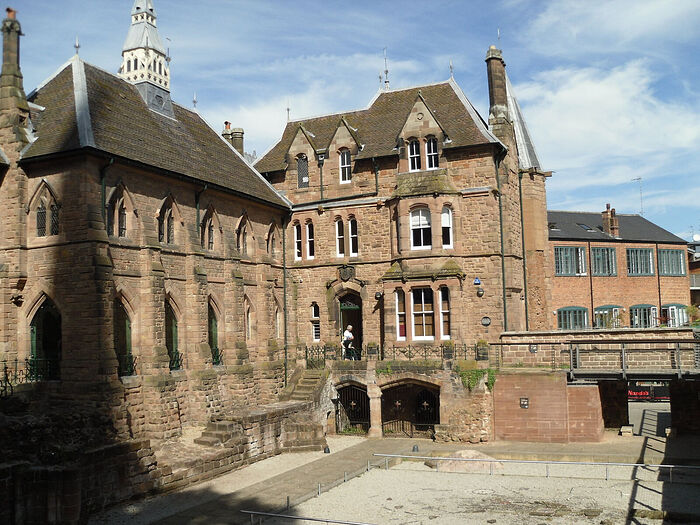 The ruins of the medieval priory-cathedral where St. Osburga’s relics were kept. Photo: Irina Lapa
The ruins of the medieval priory-cathedral where St. Osburga’s relics were kept. Photo: Irina Lapa
Though little is known of St. Osburga (Osburgh, Osburg) of Coventry,[1] volumes could be written about the spiritual legacy of the city she served in—a city that made an enormous sacrifice in WWII.
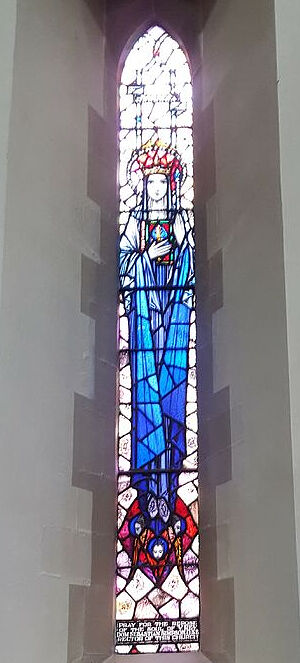 St. Osburga's stained glass window at the Lady Chapel of St. Osburg's RC Church in Coventry. Photo provided by Fr. Pontius Bandua All we can say about St. Osburga is that she was the first abbess of the convent founded in Coventry in Mercia, probably in the seventh or eighth century, according to a recent study. Coventry was once a center of the cloth and textiles trade, and now it is a huge industrial city with two universities in the West Midlands and twenty miles east of Birmingham. At that time, Coventry was a tiny settlement close to the Forest of Arden. After her repose, her shrine became famous for numerous miracles, attracting a permanent influx of pilgrims. Nothing is known about the early history of the convent. In 1016, the future King Canute of England made a raid on Mercia with his Viking band, during which the Coventry convent was destroyed.
St. Osburga's stained glass window at the Lady Chapel of St. Osburg's RC Church in Coventry. Photo provided by Fr. Pontius Bandua All we can say about St. Osburga is that she was the first abbess of the convent founded in Coventry in Mercia, probably in the seventh or eighth century, according to a recent study. Coventry was once a center of the cloth and textiles trade, and now it is a huge industrial city with two universities in the West Midlands and twenty miles east of Birmingham. At that time, Coventry was a tiny settlement close to the Forest of Arden. After her repose, her shrine became famous for numerous miracles, attracting a permanent influx of pilgrims. Nothing is known about the early history of the convent. In 1016, the future King Canute of England made a raid on Mercia with his Viking band, during which the Coventry convent was destroyed.
Shortly thereafter he became king, converted to Christianity and became a consistent supporter of the Church. It is believed that he may have later rebuilt the convent in Coventry as an act of penance. But what is known for certain is that in 1043 the monastery in Coventry was refounded or restored as a community for monks and endowed by Earl Leofric and his pious wife Lady Godiva, who is much loved and remembered in this city and of whom we will talk later. According to a now discredited version, St. Osburga lived in the early eleventh century and died about 1018 during a Viking raid. St. Osburga is mentioned in a thirteenth-century Scandinavian martyrology.
Pilgrimages to St. Osburga’s shrine continued throughout the Middle Ages, and in 1410, following petitions of the laity and clergy of Coventry, an official feast in honor of this saint was established. There was a mention of a medieval “St. Osburga’s pool” in the city. Her reliquary stood in the south transept of the post-Conquest monastery church of Coventry. Her relics were translated in 1482 within the monastery. Her splendid shrine with relics, along with her head enclosed in copper and gold, was destroyed during the sixteenth-century Reformation, and the monastery dissolved.
 Exterior of St. Osburg's RC Church in Coventry, West Midlands. Photo provided by Fr. Pontius Bandua
Exterior of St. Osburg's RC Church in Coventry, West Midlands. Photo provided by Fr. Pontius Bandua
Today the holy abbess and wonderworker is commemorated in the only church in the world that bears her name: the Roman Catholic Church of the Most Holy Sacrament and St. Osburg (commonly called “St. Osburg’s”) in Coventry. There is also St. Osburg’s Catholic Primary School in the city. The Catholic parish commemorates St. Osburga annually on September 9, to mark the church’s consecration on this day in 1845. The church in the Neogothic style is beautiful both inside and out. St. Osburga is depicted on its stained glass by the Lady Chapel and on lancets in the aisles. The church consists of a chancel, a nave with clerestory, the north and south aisles, the Lady Chapel, St. Benedict’s Chapel and a tower. The chancel and the church roof were destroyed by the German Blitz, but in the 1950s the church was restored. Among its highlights are images of saints, sculptures of angels, mosaics and windows.
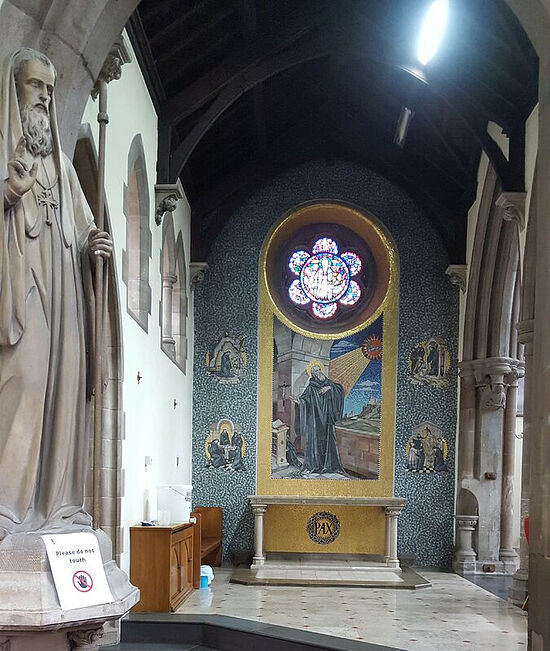 St. Benedict's Chapel inside St. Osburg's RC Church in Coventry. Photo provided by Fr. Pontius Bandua
St. Benedict's Chapel inside St. Osburg's RC Church in Coventry. Photo provided by Fr. Pontius Bandua
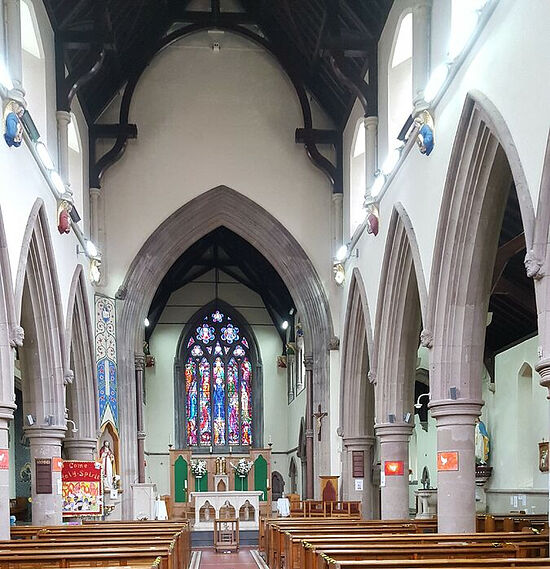 Interior of St. Osburg's RC Church in Coventry. Photo provided by Fr. Pontius Bandua
Interior of St. Osburg's RC Church in Coventry. Photo provided by Fr. Pontius Bandua
The establishment of Leofric and Godiva in Coventry was known as St. Mary’s Abbey, which was later dedicated to the Mother of God, St. Peter, St. Osburga and All Saints.
Today pilgrims visit three sites in Coventry. For convenience, we will refer to them as “the medieval priory-cathedral ruins,” “the Old Cathedral” and “the New Cathedral.”
The minor ruins of the medieval priory-cathedral are where St. Osburga’s relics were kept. The west end and other ruins are preserved close to the city’s Holy Trinity Church. St. Mary’s Abbey founded by Leofric and Godiva was beautiful and rich and, according to early authors, no other English church or monastery of the time had so much land and so many precious ornaments of gold and silver as it did. It was transformed into St. Mary’s priory and cathedral in the early twelfth century with the establishment of the new Diocese of Coventry (medieval England had many “monastery-cathedrals”). Its construction continued till 1250. The priory enjoyed royal patronage. The priory-cathedral was 425 feet long and 145 feet wide and had three towers. Earl Leofric was buried there in 1057 and his righteous wife found her resting place next to him.[2] In 1539, the priory was dissolved, and when the city residents were unable to raise the required sum to purchase the cathedral, it was pulled down; ironically, it was the only cathedral demolished by Henry VIII. At that time the bishop’s see was transferred from Coventry to Lichfield.
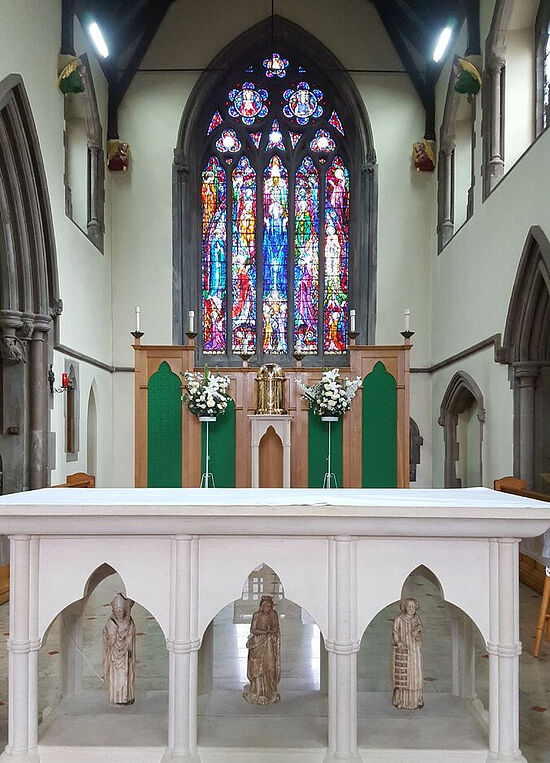 The sanctuary and altar of St. Osburg's RC Church in Coventry. Photo provided by Fr. Pontius Bandua
The sanctuary and altar of St. Osburg's RC Church in Coventry. Photo provided by Fr. Pontius Bandua
The ruins of the enormous monastery were left to decay and over time were forgotten. In the 1850s, during the reconstruction of a school on the site of the priory-cathedral, the remains of one of its walls and the tower base were discovered. Large-scale archeological excavations undertaken from the 1960s on revealed many interesting details and finds, e.g. a fragment of a medieval wall-painting depicting the Apocalypse. A statue of the Virgin, called “Our Lady of Coventry,” was unveiled among the ruins not long ago, and is prayerfully revered by believers. In the 1990s it was decided to develop part of the area as a public park. There is a small museum attached to the site, displaying some of the finds.
The Old St. Michael’s Cathedral once was one of the largest churches in England, with a spire of about 290 feet,[3] it was 293 feet long and 140 feet wide. Built of red sandstone in the fourteenth and fifteenth centuries in the Gothic style, for the first five centuries of its history it was used as St. Michael’s parish church. When in 1918, after a gap of 400 years, the Diocese of Coventry was re-established, and St. Michael’s Church became St. Michael’s Cathedral. Alas, it was destined to serve as a Cathedral for only twenty-two years.
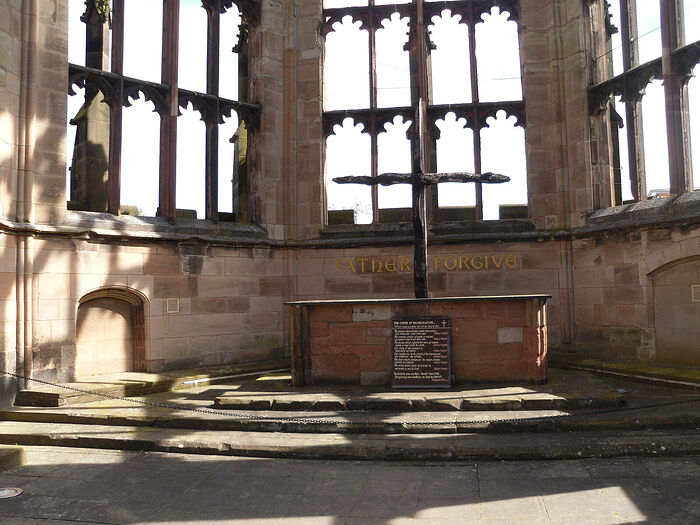 The altar and the Charred Cross by the bombed cathedral in Coventry, West Midlands. Photo by Irina Lapa
The altar and the Charred Cross by the bombed cathedral in Coventry, West Midlands. Photo by Irina Lapa
As a major center of advanced industries, Coventry was bombed by the Luftwaffe many times during WWII and, aside from London, Plymouth and Hull, suffered more damage than any other English city. The most terrible air raids were on the night of November 14/15, 1940, when several thousand high-explosive Nazi bombs fell on the city center, entirely devastating it and destroying the Old Cathedral overnight. Over 4,300 houses were razed to the ground, and two thirds of the city’s buildings were severely damaged, leaving around 570 people dead and 860 injured. The damage was so heavy the Nazis began to use the term “coventried” (“coventriert”) when describing enemy cities with a similar level of destruction. Only the outer wall of the once-huge cathedral, along with its high spire, miraculously survived. A stonemason saw two beams lying in the shape of a cross after the bombing and tied them together to form a cross, erecting it amid the ruins. This symbol is known as the Charred Cross. The current one is a more recent replacement and it can be seen on the altar of rubble by the Old Cathedral’s wall.
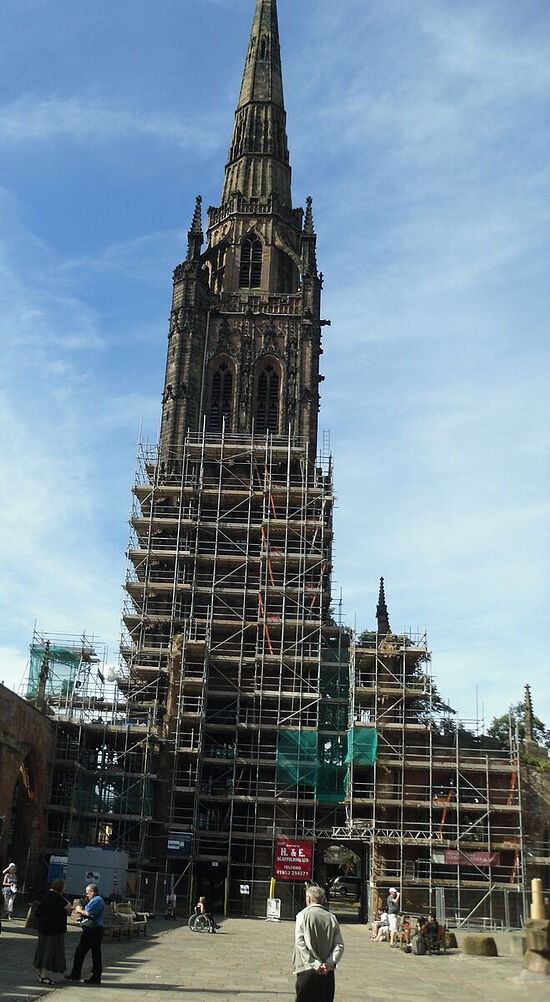 The spire of the bombed cathedral in Coventry. Photo by Irina Lapa
The spire of the bombed cathedral in Coventry. Photo by Irina Lapa
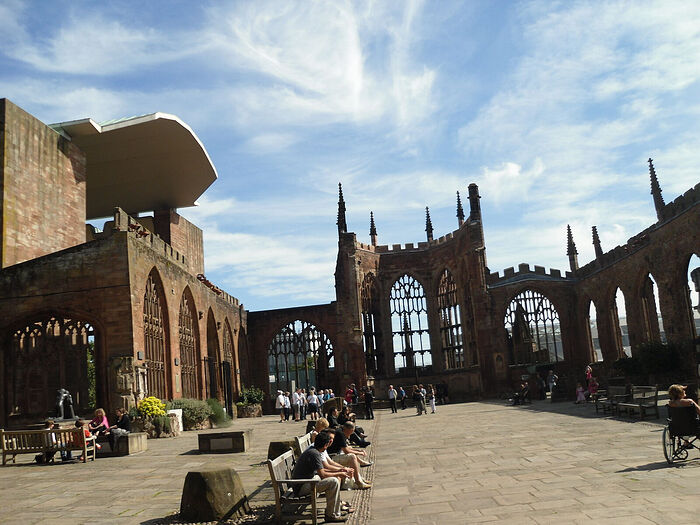 Ruins of the bombed cathedral and the new cathedral in Coventry, West Midlands. Photo by Irina Lapa
Ruins of the bombed cathedral and the new cathedral in Coventry, West Midlands. Photo by Irina Lapa
The following day after the bombing, the cathedral’s provost chalked the words “Father forgive” on the former sanctuary wall, promising to work with former enemies to create a kinder and Christ-centered world after the war. These words are repeated in the Litany of Reconciliation by the faithful of Coventry (and outside) every weekday. Its text is as follows:
All have sinned and fallen short of the glory of God.
The hatred which divides nation from nation, race from race, class from class,
FATHER FORGIVE
The covetous desires of people and nations to possess what is not their own,
FATHER FORGIVE
The greed which exploits the work of human hands and lays waste the earth,
FATHER FORGIVE
Our envy of the welfare and happiness of others,
FATHER FORGIVE
Our indifference to the plight of the imprisoned, the homeless, the refugee,
FATHER FORGIVE
The lust which dishonours the bodies of men, women and children,
FATHER FORGIVE
The pride which leads us to trust in ourselves and not in God,
FATHER FORGIVE
Be kind to one another, tender hearted, forgiving one another, as God in Christ forgave you.
Initially, the suggestion was to reconstruct or restore the Cathedral, but soon it was decided to keep the ruined shell untouched so it might serve as a war memorial and a strong reminder to posterity about the futility of war and the consequences of human cruelty. Thousands of people come to pray and contemplate amid these ruins. Every year open-air Anglican services are celebrated in this place, and there is a tiny museum beside the ruins relating the war history of this site and the Cathedral bombing. As Nick Mayhew-Smith writes in his Britain’s Holiest Places,
A small museum by the entrance contains a small stone sculpture of a nun believed to be St. Osburga. The symbolic importance of this little effigy is overlooked, though she could be held up as a figure of reconciliation and unity. Osburga dates from the early Church, at a time when there were no substantial divisions between the Churches. Small though the sculpture is, it was found in the wreckage of the bombed cathedral by a policeman. The policeman put it in his pocket and took it home. Later, when he was close to death in hospital, he confessed and sent the sculpture back to the Cathedral. A miraculous recovery soon followed, and the Cathedral regained the city’s founding saint. Osburga is linked to all three of the city’s Cathedrals, a unifying figure across time and denominations. An icon called the Stalingrad Madonna [drawn by a German soldier, Kurt Reuber, in 1942.—Auth.] is displayed in the museum, a gift donated by the people of the Russian city, which was also bombed to rubble by the Nazis.
The sculpture called “Reconciliation,” symbolizing the reconciliation of those divided by war, was created in 1977 by the sculptor Josefina de Vasconcellos (1904–2005). In 1995, its bronze cast was installed at the Old Cathedral’s ruins to mark the fiftieth anniversary of the end of WWII.
There was a legend that one of the Victorian windows from the Old Cathedral survived, and during the war was secretly shipped to Iceland, where it ended up at the church of the town of Akureyri and has been kept there ever since. Known locally as “the Coventry window,” it depicts the Presentation of Christ. However, some historians argue that the window has nothing to do with Coventry.
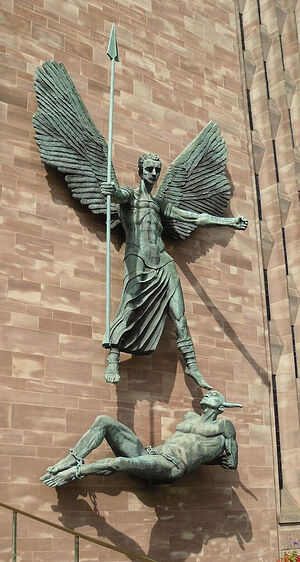 The sculpture of St. Michael vanquishing the devil on the wall of the new cathedral in Coventry. Photo by Irina Lapa Lastly, there is the modern Anglican St. Michael’s Cathedral, built next to its bombed predecessor and consecrated in 1962. It was built between 1956 and 1962 according to the design of the architect Basil Spence (1907—1976), and the foundation stone was laid by Queen Elizabeth II. Soon after its consecration, Benjamin Britten’s War Requiem, composed especially for that event, was premiered in it. With an eighty-foot spire, this masterpiece is wholly dedicated to reconciliation and hope. Its exterior is of red sandstone, the high porch has many steps, concrete blocks were used in the interior, and the floor is of polished fossil stone. The most notable exterior feature is the 1958 bronze statue of the Archangel Michael vanquishing satan, mounted on the south end of the east wall. This famous sculpture symbolizes the victory of good over evil. Its author is Jacob Epstein (1880–1959), a British sculptor of Russian-Polish Jewish descent who was born in the USA.
The sculpture of St. Michael vanquishing the devil on the wall of the new cathedral in Coventry. Photo by Irina Lapa Lastly, there is the modern Anglican St. Michael’s Cathedral, built next to its bombed predecessor and consecrated in 1962. It was built between 1956 and 1962 according to the design of the architect Basil Spence (1907—1976), and the foundation stone was laid by Queen Elizabeth II. Soon after its consecration, Benjamin Britten’s War Requiem, composed especially for that event, was premiered in it. With an eighty-foot spire, this masterpiece is wholly dedicated to reconciliation and hope. Its exterior is of red sandstone, the high porch has many steps, concrete blocks were used in the interior, and the floor is of polished fossil stone. The most notable exterior feature is the 1958 bronze statue of the Archangel Michael vanquishing satan, mounted on the south end of the east wall. This famous sculpture symbolizes the victory of good over evil. Its author is Jacob Epstein (1880–1959), a British sculptor of Russian-Polish Jewish descent who was born in the USA.
Inside, the Cathedral has an Ecumenical Chapel of Unity with a mosaic floor representing the nations of the world—it is designed for use by different Christian denominations. There are also the nice and quiet Chapel of Christ in Gethsemane, the Chapel of Industry (or Christ the Servant), and the Millennium Chapel. The tall slender columns have a Gothic feel. The color and light of the stained glass windows create a memorable impact. The chancel, nave and chapter house are very fine. Behind the High Altar, sitting in the center of the altar cross, is one of the edifice’s highlights: a small cross made of three large medieval iron nails found within the bombed Old Cathedral. For the purpose of peace and better understanding between nations, the Cathedral made several hundred similar crosses and donated them to many countries across the globe, including to cathedrals of Dresden and Berlin.
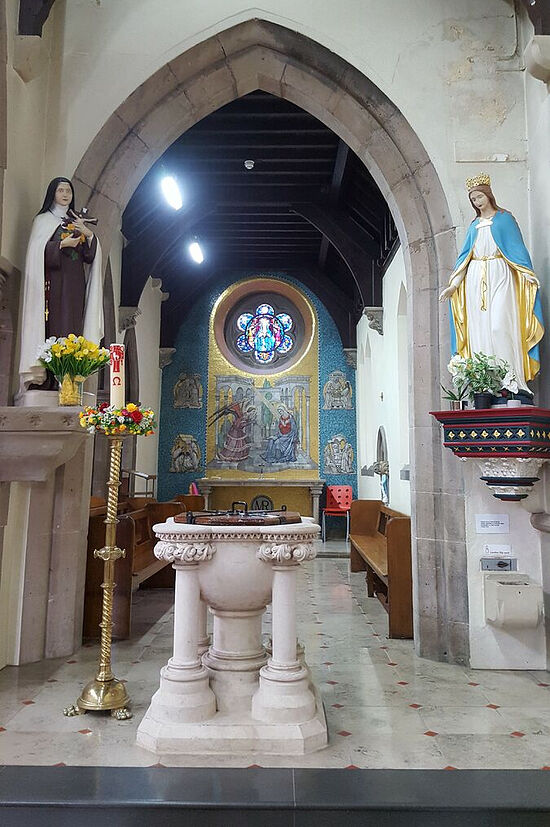 Lady Chapel of St. Osburg's RC Church in Coventry. Photo provided by Fr. Pontius Bandua
Lady Chapel of St. Osburg's RC Church in Coventry. Photo provided by Fr. Pontius Bandua
Behind the High Altar hangs an enormous tapestry of Christ by the artist Graham Sutherland (1903–1980), called “Christ in Glory in the Tetramorph.” It measures seventy-five by thirty-nine feet, and until recently it was the largest tapestry made of one single piece in the world. Another delight is the eighty-one feet high Baptistry Window, stretching from floor to ceiling and containing 195 lights of stained glass, designed by the artist John Piper (1903–1992). At the foot of it stands the font made from a boulder brought from Bethlehem. Another notable sculpture is Mater Dolorosa (representing the Virgin sorrowing over the death of Jesus) in the Lady Chapel by the sculptor John Bridgeman (1916—2004). The great western window featuring angels and saints is also worth mentioning. Though criticized by some for its modernist style, many visitors find this cathedral inspiring. Justin Welby, the current Archbishop of Canterbury, served as canon at Coventry Cathedral between 2002 and 2007.
All these places are concentrated in the city center.
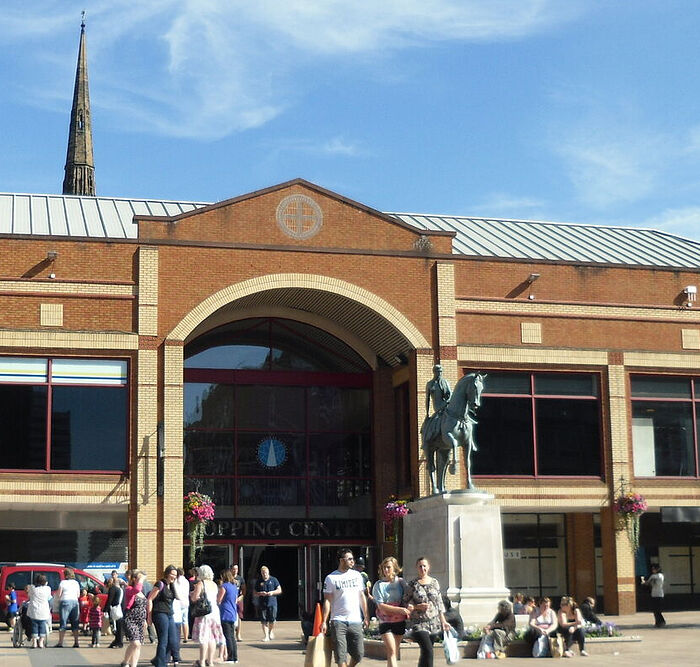 A monument to Lady Godiva in Coventry, West Midlands (photo by Irina Lapa)
A monument to Lady Godiva in Coventry, West Midlands (photo by Irina Lapa)
Coventry’s central square, Broadgate, boasts a bronze equestrian statue of Lady Godiva called “Self-Sacrifice.” It was created by the sculptor William Reid Dick (1878–1961) and unveiled in 1949. Museums, galleries, cafes, shops and streets of this city have a wealth of reminders dedicated to this noble, powerful and kind-hearted English noblewoman, with numerous works of art commemorating her. Lady Godiva (Godgifu: “gift of God”; died between 1066 and 1080) is best known for the fact that she agreed to the proposition of her husband, Earl Leofric of Mercia, that he would reduce unpopular taxes if she rode naked[4] on horseback through the marketplace of Coventry. All the townspeople refrained from watching, except for “Peeping Tom,” who was struck blind as a Divine punishment. A legend or not, Godiva was loved by common folk for her kindness, compassion, care for the poor, love of the Church and as an intercessor for the people. Apart from Coventry, it is known that this couple (under Godiva’s influence) rebuilt or generously endowed the major monasteries of Chester, Evesham, Leominster, Much Wenlock, Worcester and the minster in Stow. She bequeathed works of precious metal, expensive necklaces, gold and silver crosses and chasubles to important English churches and cathedrals. Some consider her a saintly figure.
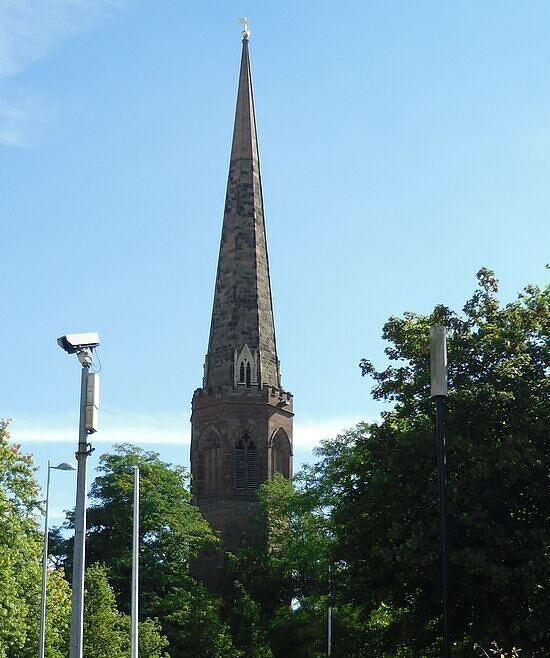 The spire of Christ Church Greyfriars in Coventry, West Midlands. Photo by Irina Lapa
The spire of Christ Church Greyfriars in Coventry, West Midlands. Photo by Irina Lapa
There were a number of other medieval monasteries in Coventry: the White Friars (Carmelite) Monastery (founded in 1342, its cloister walk survives and is used by the Herbert Art Gallery Museum); the Carthusian St. Anne’s Priory (founded in 1381, part of it is preserved as a scheduled monument with grounds); and the Franciscan Monastery, or Greyfriars (founded in 1350). Coventry is sometimes called “the city of three spires,” as it is noted for the three surviving high spires of Christ Church (built by the Franciscans, reconstructed in the nineteenth century, damaged in WWII and later demolished, leaving only the tower with its 200-foot spire); of the bombed St. Michael’s cathedral; and of the Holy Trinity Church.
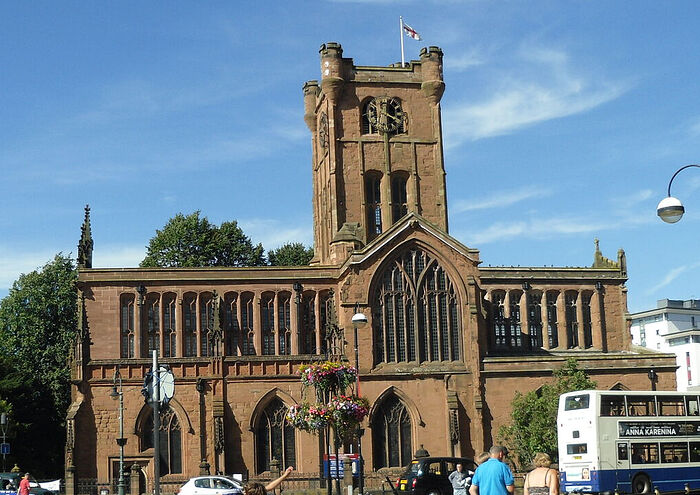 St. John the Baptist's Church in Coventry, West Midlands. Photo by Irina Lapa
St. John the Baptist's Church in Coventry, West Midlands. Photo by Irina Lapa
Among the important parish churches of Coventry, we should mention the Anglican Holy Trinity Church and St. John the Baptist Church. The Holy Trinity Church was built by monks in the thirteenth century, though the original one was much earlier. By miracle it came through the Blitz unscathed, only the east window was blown out. The church is spacious, cozy, light and atmospheric. It is noted for the bright, fifteenth-century Doom painting (of the Last Judgment—discovered under limewash) above the chancel arch, the Peace Chapel, Jesus Chapel and various windows, e.g. the Brides’ Window by Ninian Comper and the west window depicting Christ in majesty surrounded by church figures.
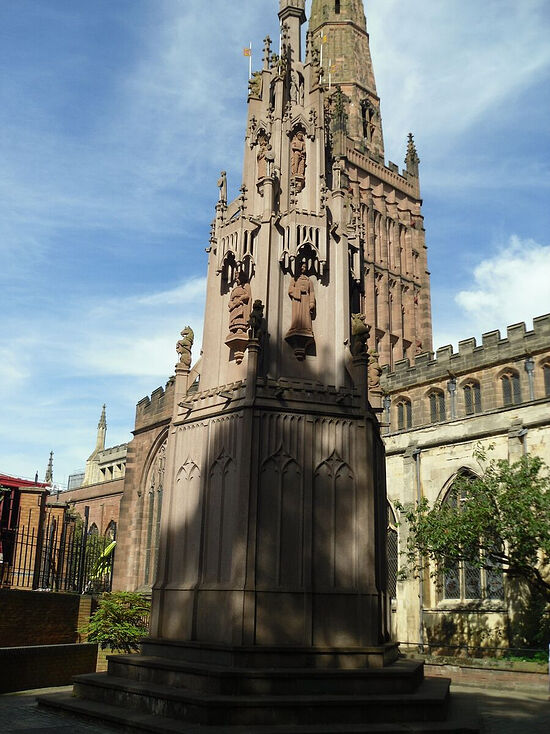 The Holy Trinity Church and the replica of the city cross in Coventry. Photo by Irina Lapa
The Holy Trinity Church and the replica of the city cross in Coventry. Photo by Irina Lapa
The font, pulpit and eagle lectern are ancient. It has one of the highest (236 feet) non-cathedral spires in the UK. There is a replica of Coventry’s city cross in front of the church. Mary Ann Evans, known under her pen name of George Eliot, was the most famous parishioner of this church. St. John the Baptist’s Church was built in about 1350 and at one time was a guild and collegiate church. From the late sixteenth-century it was used as a prison, stables and a market, but was re-consecrated again in the eighteenth century. It holds a particle of the relics of St. Valentine of Rome, a patron of love and marriage. The interior retains pre-Reformation carved figures on pillars and arches, including an alabaster section featuring the Magi. The parish observes the “Anglo-Catholic” tradition of Anglicanism, initiated by the Oxford (Tractarian) movement in the nineteenth century. It is often used as a venue for concerts. It stands on Spon Street, a restored medieval street with many intact ancient original and relocated buildings. About thirteen Protestant martyrs, all of whom were Lollards, were executed in Coventry in the sixteenth century and are commemorated there.
There is also a modest Orthodox presence in Coventry, with the Greek Holy Transfiguration parish. Today St. Osburga is remembered by some Orthodox. This early saint deserves wider veneration as a uniting figure in the great yet turbulent history of this city.[5] Among the twenty-six twin-cities of Coventry is Volgograd (formerly Stalingrad) in Russia—these cities’ friendship was cemented by the great devastation of both during WWII.

